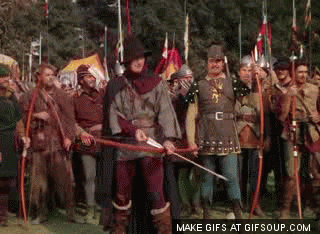Archery
I've always been fascinated with bows. I had a couple growing up. Nothing serious, not even the sucker-tip arrows one of my brothers popped me in the forehead with while I was walking by the bathroom one day. I got a recurve model that could send an arrow about 100 yards. I would launch arrows (full length but with rubber tips) from the lawn next to my apartment building onto the lawn of the elementary school across the street. Probably one too many viewings of the The Adventures of Robin Hood served as inspiration ...

It followed that archery would feature in my writing. As I began to conduct research for VENDETTA (in which archery doesn't play a very prominent role), I discovered a lot of myth-busting had taken place regarding the employment of war bows (long bow is not the proper terminology ... not for the 14th century). Advancements in ballistic technology and subsequent discoveries by amateur and professional historians/archaeologists shed much more light in just how much damage a heavy war arrow launched from a self bow with a 160lb draw weight (or even heavier) could inflict on a fully armored knight. Turns out the descriptions of clouds of arrows filling the skies, of massed ranks of English archers shooting in unison, were not quite correct.
Without getting too much into the weeds, the effective velocity and penetrating power of an arrow drops precipitously after 40 or 50 yards. At Crećy and Poitiers, the English weren't firing volleys of arrows at targets two to three hundred paces distant. They were instead hitting French cavalry and dismounted knights at much closer ranges. Too far and arrows would just shatter or bounce off their target's armor. ,At close ranges, even arrows which failed to penetrate plate armor delivered substantial blunt trauma. Archers also tended to target horses. A knight thrown from horseback was easier to kill or subdue. Dead or injured horses also disrupted advancing ranks.
Another consideration I never took into account was how exhaustive combat shooting could be for archers. English archers began their training fairly young. It took years to develop the reflexes, coordination, and back/shoulder strength to master the heavy draw weights required for combat shooting. Even so, pulling a bow with a 170lb draw weight wiped out an archer after a dozen or so well-aimed shots. Instead of a static line of archers, I envision something a little more fluid took place. Exhausted bow men would back off the line to recuperate. Rested archers would replace them. This also -- IMHO-- is one of the reasons why English armies during the Hundred Years War had such huge contingents of archers in their ranks.
So! Let the experts show you how it's done. War bow versus plate armor ... Check out this great video from Tod's Workshop on YouTube.
https://www.youtube.com/watch?v=DBxdTkddHaE



